February 11, 2020
When Academics Become Entrepreneurs
Just as our human body has a sophisticated regulation system that uses various transmitter substances, plants must also have a similar regulating system - but how does it work? A basic research project that attempted to answer this question led to the establishment of a startup company that develops new plant cultivars. A physicist involved in an accelerator program trying to unravel the mystery of the Big Bang at the beginning of the universe decided to start a company to apply the technology born out of the program to a different field. A research engineer frustrated by the absence of corporate willingness to develop a new technology into a commercial product decided to do it himself by starting his own company. What paths did these researchers follow to the wider world from their state-of-the-art university labs?
In the simplest terms, the research theme of Michitaka Notaguchi, Associate Professor at the Nagoya University Graduate School of Bioagricultural Sciences and School of Agricultural Sciences, is to "prove, based on concrete evidence, that plants are not that stupid." No textbooks say that plants - which cannot move themselves - are high-order organisms. However, it is becoming clear that most of the functions animals possess, such as immunity to purge foreign bodies, are also present in plants, albeit based on a different mechanism. It is not true that plants are simpler life form compared to animals.
The problem is that we only know of around ten types of hormones that control the bodily functions of plants. They only convey vague messages such as "stressed" and "want to grow" and do not provide specifics like which part is feeling what sort of stress or into what form the plant wants to grow. There must be a different group of substances that are carrying these details in order to fine-tune the plant's regulation system.
We know that there are many molecules in our bodies that act as messengers carrying information such as "there isn't enough oxygen." As this century sees more and more genetic information being deciphered, we are beginning to understand that plants also have what can be termed as a vocabulary of information-carrying molecules. If we can read them, we can understand what plants are thinking and what they need. We can start talking with plants, and that can change the world, says Notaguchi.
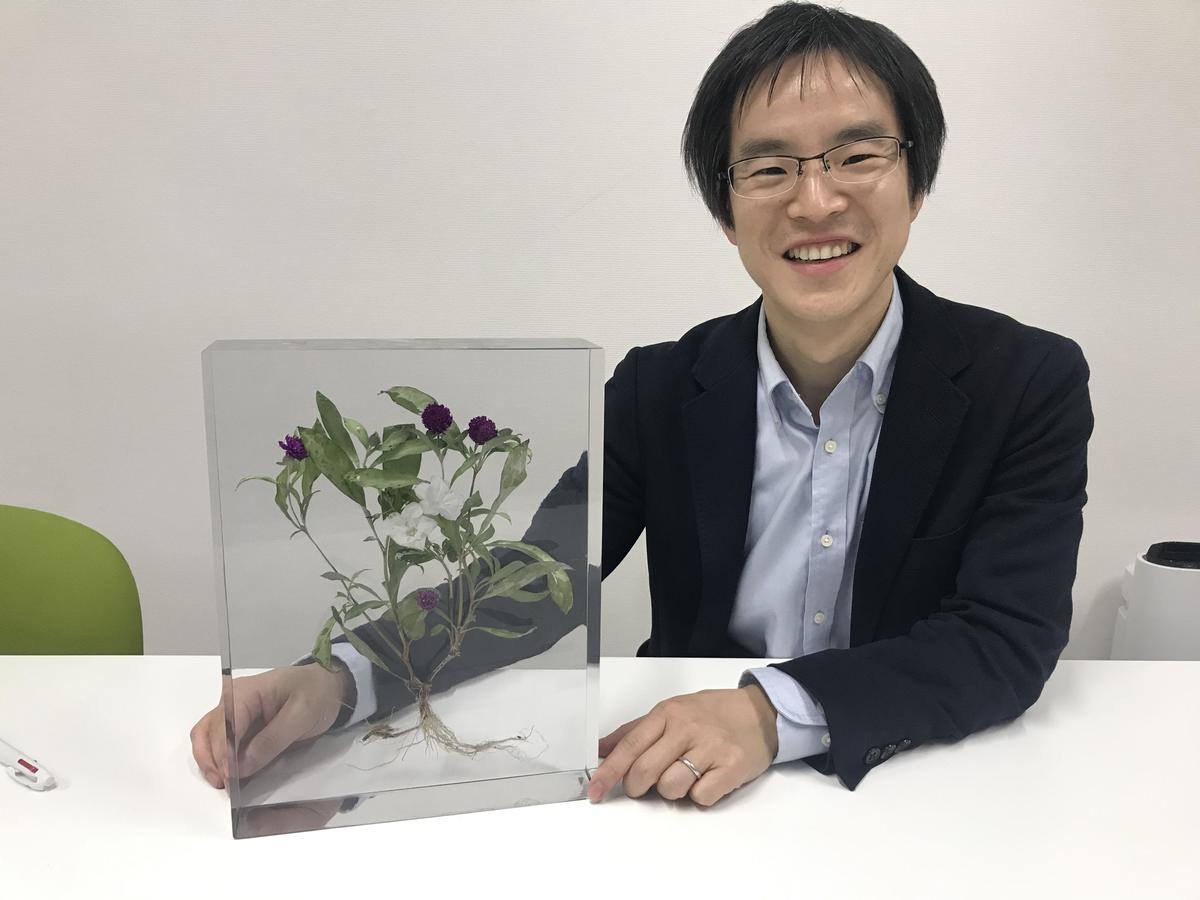 Associate Professor Michitaka Notaguchi with a specimen of a white-flowered petunia, a close relative of the tobacco plant, grafted onto a purple globe amaranth
Associate Professor Michitaka Notaguchi with a specimen of a white-flowered petunia, a close relative of the tobacco plant, grafted onto a purple globe amaranth
The method he employed in this research - and ultimately led to the business venture - was a very old horticultural technique called grafting. Grafted plants can be used to see how substances produced by the rootstocks are carried to and act in the grafted scions of different plants. A breakthrough came through his chance discovery that, unlike most other plants, tobacco could be grafted onto any plants, not just closely related species. He was carrying out his research at a university in the US, and it was going nowhere. He could not find a way forward and, not knowing what else he could do, he took a piece of tobacco plant at hand, which was in the lab as a plant for experiment, and grafted it onto a rootstock from a different species of plant. To his surprise, it took with ease. The technique of grafting had been in use for two millennia, yet this was the moment when a completely new potential of this ancient method opened up. By using tobacco as a joining piece, almost any plant can be grafted onto any other plant. Grafting has already made it possible to create an improved tomato plant that has a strong root system and bears numerous fruits, but with this new technique, the potential of grafting to improve plants will not be limited to tomatoes. In theory, infinite number of new cultivars can be created by combining different plants, such as a crop plant grown on a draught-resistant rootstock that can withstand desert conditions.
Further research also discovered that grafted tobacco scions acted as conduits for the genetic material RNA. This means that this technique can be used to edit the genome of the plant and produce seeds that have desired characteristics. In this way, it may be possible to create new plant varieties more efficiently.
Notaguchi has long desired to contribute as a botanical scientist in the effort to tackle the many issues caused by climate change. When he "happened upon a technology that had a potential to develop new cultivars that might alleviate food security issues," he was eager to bring it to the wider world. Although his first instinct was to form an industry-academia partnership, no company was willing to come on board the development project. He concluded that he had to do it himself and founded Gra&Green Inc. in 2017.
In addition to the development of new cultivars, another core business of the company is the sales of automatic grafting systems. It is hoped that this will provide a stable income stream needed to be a viable concern. The company used a prototype produced using a 3D printer at the university to develop a commercial version, which goes on sale this month. The management team is headed by Masaki Niwa, a former junior lab mate from Notaguchi's Kyoto University days, who left his assistant professor position at Kyoto University to join Gra&Green Inc. as its president.
Notaguchi himself has moved away from the day-to-day management of the company now and is focusing on his research instead. Grafting takes advantage of plants' ability to heal wounds, and most plants reject other plants. So why does tobacco, and only tobacco, accept other species? He is focusing on this question which leads to the fundamental nature of plants and at the same time may pave the way to commercial applications.
Looking back, he remembers the days when he felt desperate as he thought that, with his position as a researcher being by no means secure, the only way his technology could do something good was to persuade someone else to use it. This changed in 2015, when the Nagoya University's support for business startup projects began in earnest through its Academic Research & Industry-Academia-Government Collaboration (AR&IAGC) unit. He says that its support gave him a momentum to take a step into entrepreneurship.
Masahiro Kito, Leader of the Intellectual Property & Technology Transfer Group at AR&IAGC, joined Meidai in 2014 from Panasonic, where he worked in the field of intellectual property for many years. A graduate from Meidai's School of Engineering, he spent his postgraduate years at Professor Isamu Akasaki's lab as part of his blue LED research team. Kito explains that, in 2015, when a venture fund was set up and support initiatives such as entrepreneurship training started, the number of startups at Meidai shot up from just one in the previous year to ten. The Tongali (meaning to be unique in Japanese) Project, a project run jointly with other local universities to encourage student startups, has also taken off, and with these entrepreneurship support initiatives, student startups are also on the increase.
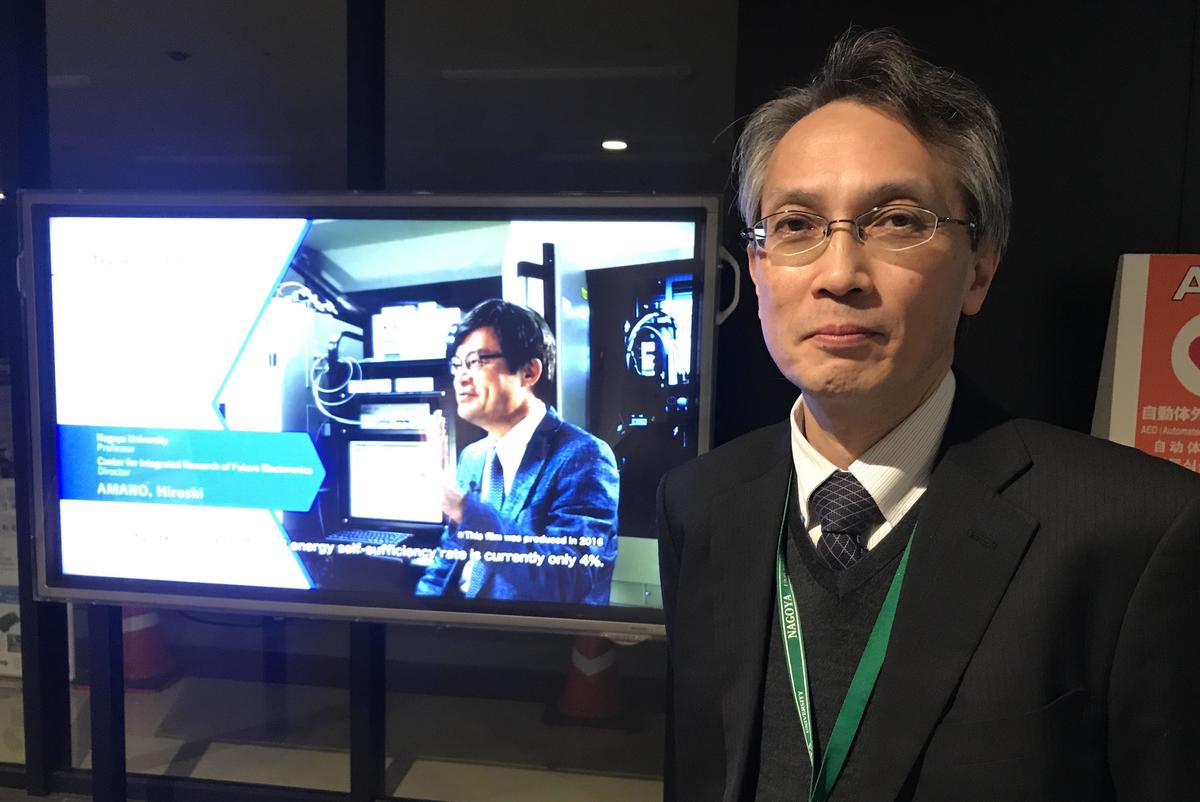 Professor Masahiro Kito of AR&IAGC, a former junior lab mate of Professor Hiroshi Amano at the Akasaki Lab.
Professor Masahiro Kito of AR&IAGC, a former junior lab mate of Professor Hiroshi Amano at the Akasaki Lab.
Takayuki Suzuki had been working under Kito at AR&IAGC to provide support for startups when he decided to leave the university and become the president of one of these startups from the class of 2015. He had received his PhD in molecular biology at the Nagoya University School of Agriculture and, when time came to choose between continuing his research and aim to achieve a "world's first" or applying his genetics research to practical uses such as medical treatments, he opted for a job that connects research outcomes to the society and joined Meidai. He explains that his experience of studying at a university in the US and seeing the process of technology transfers first hand influenced his decision.
His role in startup support put him in contact with Tomohiro Nishitani, who had been researching electron beams for over 20 years. After completing his doctoral study in particle physics at Meidai, he joined the Japan Atomic Energy Agency, working on the research in the electron beam generator for its high-energy accelerator experiment. It was an ancillary field of research in the world of particle acceleration, which made it difficult for him to secure a researcher post. He chose the path of applied science instead, seeking industrial applications for the electron beam technology such as electron microscopes. He moved to the Institute of Physical and Chemical Research (Riken) before returning to Meidai to continue his research into electron beam generators that use a type of semiconductor called semiconductor photocathodes. This works in reverse of the blue LED, which turns electrons into light; shining light onto a semiconductor photocathode causes it to emit electrons. This is called the photoelectric effect, the discovery of which won Einstein his Nobel Prize.
For the last half a century, electron beams were obtained by applying heat, for instance, to metals, and it was almost impossible to control where or when electrons were emitted in this way. Nishitani's method, on the other hand, allows electron beams to be fine-controlled almost to the particle level. It enables electron microscopes to capture the minute structure of protein as it moves around in a fluid, which was hitherto impossible, and has a potential to improve the precision of electron beam microfabrication dramatically.
"If we can commercialize it, it will change the world," Nishitani told Suzuki. Being a biologist, Suzuki did not quite understand how, but the fact that the novelty of this invention was instantly recognized in the patent application convinced him of its potential.
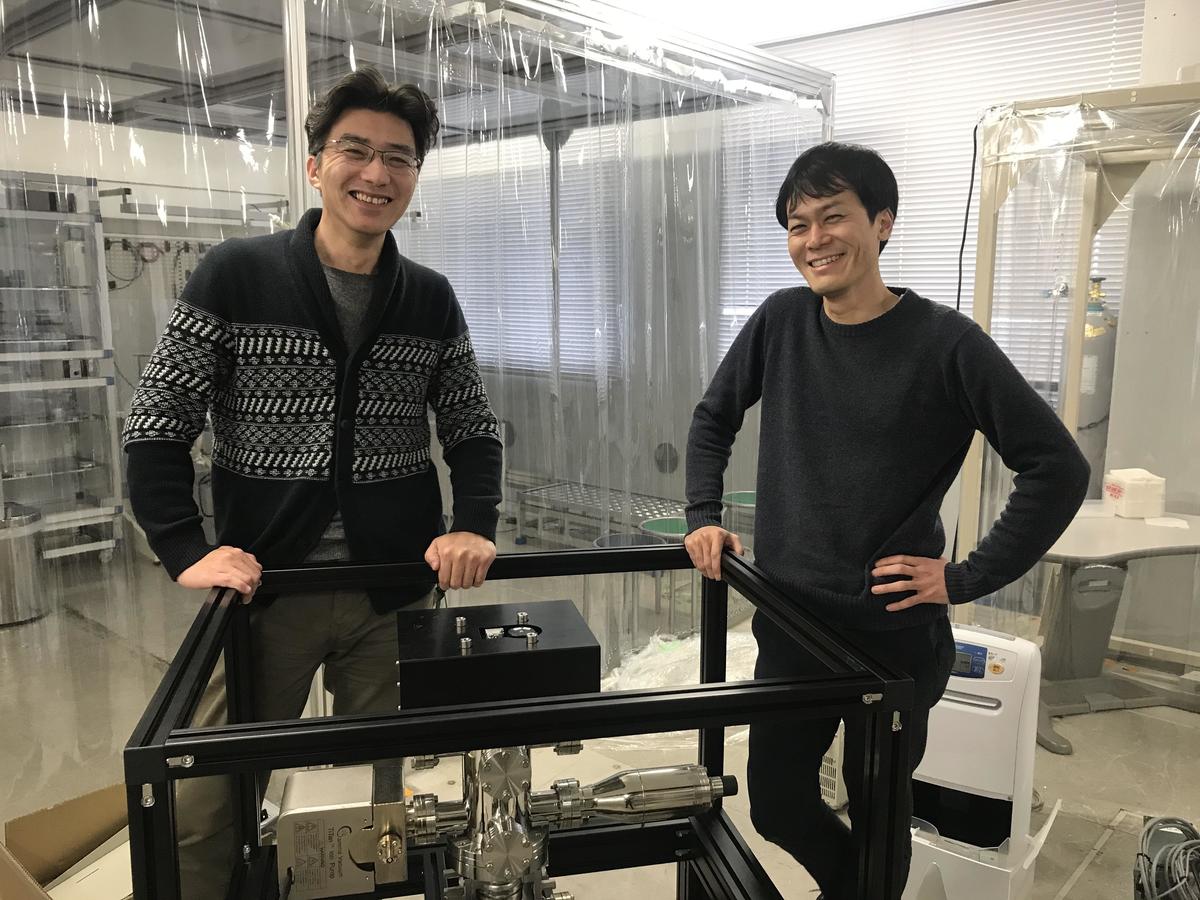 Takayuki Suzuki (right), CEO of Photo Electron Soul, and Tomohiro Nishitani, Chief Technology Officer, in front of newly completed electron beam generator.
Takayuki Suzuki (right), CEO of Photo Electron Soul, and Tomohiro Nishitani, Chief Technology Officer, in front of newly completed electron beam generator.
They initially sought a corporate partner, but although plenty of companies showed interest, talks never seemed to go further. For companies that already use electron beams, it is a long-established core technology that is hard to change. They realized that they had to do this themselves. The two enrolled in a startup training program launched by the New Energy and Industrial Technology Development Organization (NEDO) and won the top prize in its inaugural startup competition. This gave them an opportunity to present their idea to Silicon Valley investors, and the response they received boosted their confidence.
They set up their company soon after and called it Photo Electron Soul - they were literally putting their soul into their photoelectron venture.
Nishitani reckons that it was thanks to the traditional strengths of Meidai that they were able to achieve a world's first with this new technology. For 30 years, the Nagoya University School of Science has been at the forefront of research into semiconductor photocathodes as electron sources in the field of particle physics, leading in a fierce race against the Stanford University in the US. Meidai has been able to combine a pool of cutting-edge element technologies from wide-ranging fields such as semiconductor, laser and vacuum, working also with companies in the surrounding area.
When Nishitani picked gallium nitride as a best candidate material for the semiconductor, he was able to call on the help of an expert: Professor Hiroshi Amano, who developed the blue LED using the same material. Nishitani met the professor through an introduction and Amano was happy to help. This was before Amano was jointly awarded a Nobel Prize.
One person Nishitani feels deeply indebted to is Akira Tonomura, a fellow of Hitachi, Ltd., the only person who saw a potential in his lonely research and encouraged him to keep working at it. Tonomura was a physicist known for his observation of strange behaviors of quanta using a special electron microscope called electron holography, research that people thought would earn him a Nobel Prize. On a particle accelerator, the electron beam generator is as big as a small house, and turning it into a commercial product that could be used in electron microscopes would require a huge reduction in physical size. Tonomura insisted on more and more reduction. This was hard, but Nishitani kept at it in the hope of surprising Tonomura. He finally succeeded in 2013, a year after Tonomura passed away.
Meidai was once the world-renowned center for electron microscope research, led by Professor Ryoji Ueda. Tonomura too received his doctorate under Ueda's guidance. Another member of the team was Sumio Iijima, University Professor at Meijo University and the inventor of carbon nanotubes.
Nishitani's breakthrough technology may one day add another page to the illustrious history of Meidai's electron microscope research.
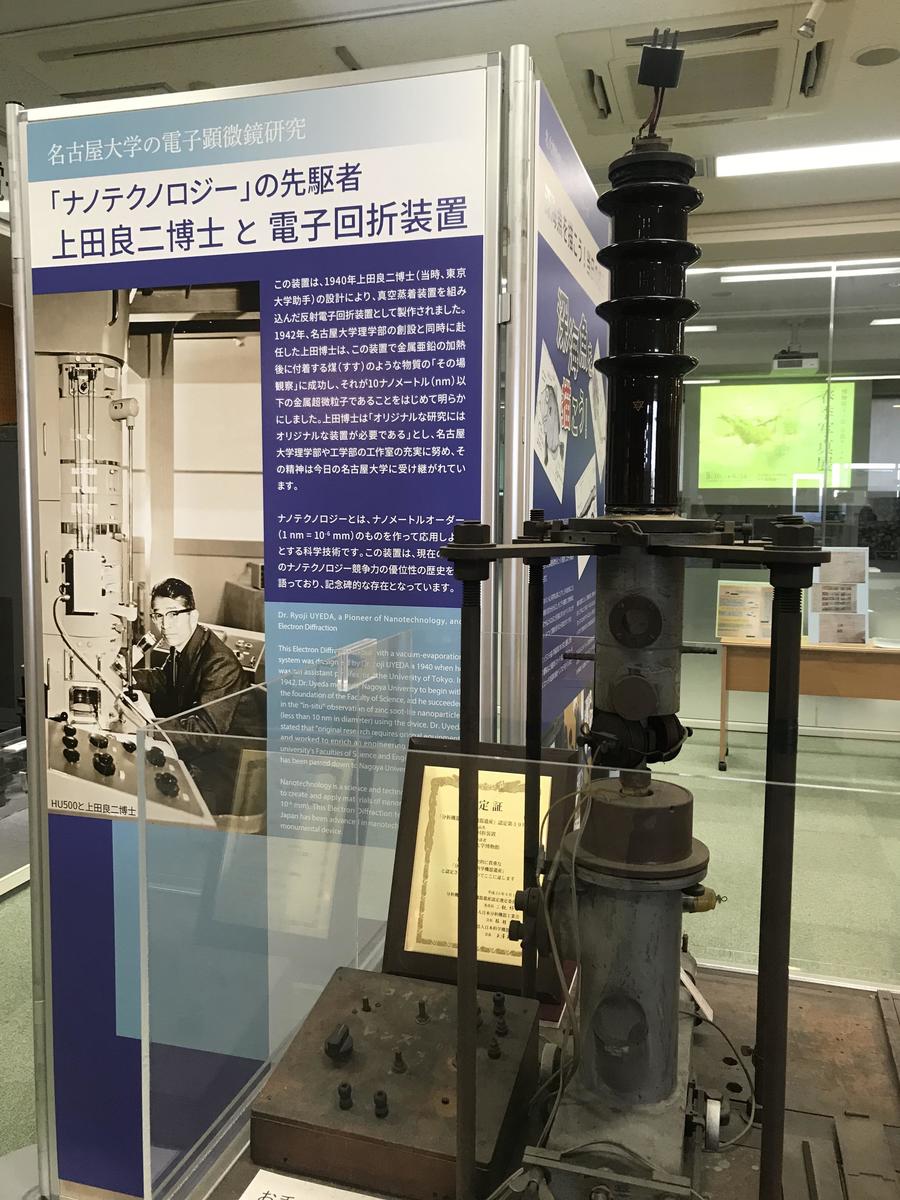 Doctor Ryoji Ueda arrived from the University of Tokyo in 1942, when the Meidai School of Science was created, and nurtured many talents. An electron diffraction apparatus he designed is displayed at the Nagoya University Museum.
Doctor Ryoji Ueda arrived from the University of Tokyo in 1942, when the Meidai School of Science was created, and nurtured many talents. An electron diffraction apparatus he designed is displayed at the Nagoya University Museum.
While Notaguchi and Nishitani are both young scientists with their first startup ventures, Professor Toru Ujihara of the Institute of Materials and Systems for Sustainability is a research engineer specializing in semiconductor devices with a wealth of experience in industry-academia partnership. A veteran entrepreneur who already had a startup company in the field of materials, he too had concluded that there was no choice but to do it himself when he founded Aixtal Corporation in November 2019.
"The idea of a university bringing its basic research outcome to a company to turn it into a commercial product through a joint R&D partnership," according to Ujihara, is an obsolete model now. These days, companies think of profitability before technological merit; there is no point in developing a product that is not going to bring in revenue that matches the scale of the company. The academia may want to keep developing new technologies, but there is nobody to receive it at the end of the road. If Japan is to bring out something new to compete against companies around the world that are eagerly pursuing new technologies, universities must step up to the plate.
Ujihara's goal is high-quality silicon carbide crystals, a material for power semiconductors for which there is a rapidly growing demand. He successfully came up with a new method of producing them, and the next challenge was to make them bigger, but no companies were interested in joint research.
An unexpected help came from artificial intelligence. Material development is a time-consuming endeavor, but simulations that would take humans many hours can be completed by AI in less than a second. He was able to quadruple the crystal size from a 1-inch piece in a mere few years, not the normal 20 years. The next stage needs money, so he decided to seek venture funding in order to take it from development to market launch.
An unexpected help came from artificial intelligence. Material development is a time-consuming endeavor, but simulations that would take humans many hours can be completed by AI in less than a second. He was able to quadruple the crystal size from a 1-inch piece in a mere few years, not the normal 20 years. The next stage needs money, so he decided to seek venture funding in order to take it from development to market launch.
Ujihara is keen to "make the company a success and make it a step towards establishing a methodology for the social implementation of new technologies." He is also working towards a circular model of channeling startup profits into basic research at the university. To him, real success is to make it possible for people who follow his footsteps to succeed. Students who share his vision have also joined in: Goki Hatasa, a second-year doctoral student, and Masaki Takaishi, who is in the first year of his master's degree course, are enthusiastic partners in the venture, hoping that it will give them an opportunity to learn management skills.
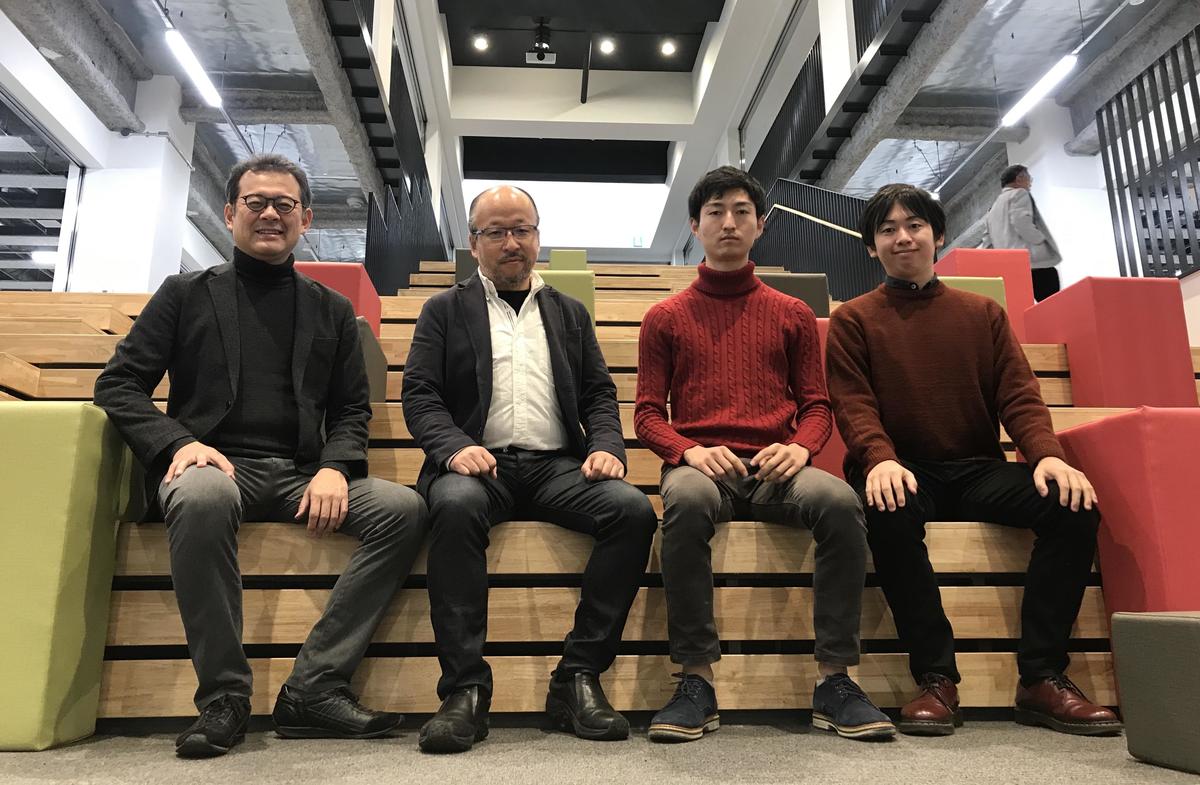 Founding members of Aixtal Corporation: (from left) Toru Ujihara, Takahiro Makino, Masaki Takaishi and Goki Hatasa.
Founding members of Aixtal Corporation: (from left) Toru Ujihara, Takahiro Makino, Masaki Takaishi and Goki Hatasa.
Ujihara met AI by chance. He was on a university business trip to Vietnam with Professor Kazuya Takeda of the Graduate School of Informatics, an expert on AI and big data, who told Ujihara about the significance of these technologies. Seeing the speed at which AI works, he was convinced that a breakthrough was possible when the light nimbleness of informatics was brought to aid the heavy lifting required in materials research. He started studying the AI technology with his lab students and applied it to materials research. The result was impressive.
Ujihara feels that Meidai is just the right size for people from different fields of research can meet and learn from one another. In Takeda's network, there is a successful startup company like Tier IV, a world-leading provider of autonomous vehicle technology. Even students set up IT ventures. "I can't lag behind students!" laughs Ujihara.
There are some common threads in these startup stories: they were convinced that their the new technologies had a potential to change the world; they felt that they had to take these technologies to the wider world themselves; they were driven by their passion; they had a team of people around them who responded to their passion and trusted the potential of the technologies; and these people were on the same wavelength. Although Nishitani chose to leave the university to focus on his business, they are all trying to change the world in their own ways, and I wish them all the best.
It reminds me of the words of Hideo Kodama, who was the first person to develop the concept of 3D printing: "the American researchers who turned the concept into commercial products must have been able to do it because he was absolutely determined to do it." Thus the 3D printer was born, and it changed the world. It is a testament to the importance of belief in the potential of a technology and of tenacity to hold on to that belief.
Universities hold many seeds of breakthrough technologies that may one day change the world. I hope to see these seeds grow and blossom.

 Subscribe to RSS
Subscribe to RSS